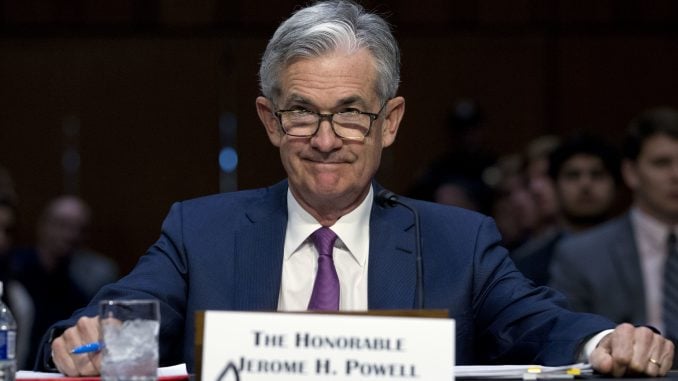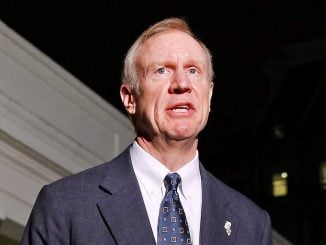
WASHINGTON, D.C. — The Federal Reserve signaled its confidence Wednesday in the U.S. economy by raising a key interest rate for a third time this year, forecasting another rate hike before year’s end and predicting that it will continue to tighten credit into 2020 to manage growth and inflation.
The Fed lifted its short-term rate — a benchmark for many consumer and business loans — by a modest quarter-point to a range of 2 percent to 2.25 percent. It was its eighth hike since late 2015. The central bank also stuck with a previous forecast for three more rate hikes in 2019.
In a statement after its latest policy meeting, the Fed dropped phrasing it had long used that characterized its policy as “accommodative” — that is, favoring low rates. The Fed had used variations of that pledge in the seven years that it kept its key rate at a record low near zero and over the past nearly three years in which it’s gradually tightened credit.
By removing that language, the Fed may be signaling its resolve to keep raising rates. In a news conference after its meeting, though, Chairman Jerome Powell said the removal of the “accommodative” language did not amount to a policy change.
“Our economy is strong,” Powell declared at the start of his news conference. “Growth is running at a healthy clip.”
The chairman added, though: “Of course, that’s not to say everything is perfect. The benefits of this strong economy have not reached all Americans. Many of our country’s economic challenges are beyond the scope of the Fed.”
The Fed’s actions and its updated economic forecasts Wednesday had been widely anticipated. Initially, there was little reaction in the stock or bond markets, but later in the afternoon, stocks sold off, and major indexes closed modestly lower.
In its updated outlook, the Fed foresees one final rate hike after 2019 — in 2020 — which would leave its benchmark at 3.4 percent. At that point, it would regard its policy as modestly restraining growth. The Fed seeks to slow the economy when it reaches full employment to prevent a tight job market from raising inflation too high.
President Donald Trump has argued publicly against higher rates, complaining that they would blunt his efforts to boost growth through tax cuts and deregulation.
The Fed’s latest forecast predicts that the unemployment rate, now 3.9 percent, will reach 3.7 percent by the end of 2018 and then 3.5 percent next year. Not since the late 1960s has unemployment fallen that low.
The central bank expects unemployment to begin rising to 3.7 percent at the end of 2021. It foresees the economy growing 3.1 percent this year before slowing to 2.5 percent in 2019, 2 percent in 2020 and 1.8 percent in 2021. The Fed sees the economy’s long-run growth at a 1.8 percent annual rate — far below the Trump administration’s projections for a sustained rate of 3 percent.
Many analysts think the economy could weaken next year, in part from the effects of the trade conflicts Trump has pursued with China, Canada, Europe and other trading partners. The tariffs Trump has imposed on imported steel and Chinese goods, in particular, complicate the Fed’s decision-making.
That’s because the tariffs — and the resulting retaliation from America’s trading partners — could weaken the U.S. economy. The Fed would normally respond to weaker growth by cutting interest rates. But tariffs, which are an import tax, can inflate prices. And the Fed typically counters higher inflation by raising rates.
Megan Greene, global chief economist at Manulife Asset Management, said she thought the tariffs were more likely to slow the economy than to accelerate inflation.
“The real risk of trade wars,” Greene wrote last week, “is a hit to growth, not a boost to inflation.”
Indeed, the Fed’s regional banks have reported that some businesses are delaying investments until they see some resolution to the trade hostilities. In his news conference, Powell said some companies have told Fed officials that the tariffs have raised fears that supply chains will be disrupted and raw materials will cost more.
Powell said he had yet to see evidence that the administration’s tariffs have raised prices for many consumers. But he said rising inflation remains a threat resulting from Trump’s trade policies.
“It’s a concern,” Powell said. “It’s a risk. You could see prices moving up. You don’t see it yet. But you could see real prices moving up. The tariffs might provide a basis for companies to raise prices in a world where they’ve been very reluctant to and unable to raise prices.”
Compounding the effects of the tariffs and retaliatory tariffs resulting from Trump’s trade war, other factors could slow growth next year. The benefits of tax cuts that took effect this year, along with increased government spending, for example, are widely expected to fade.
Still, some analysts hold to a more optimistic scenario: That momentum already built up from the government’s economic stimulus will keep strengthening the job market and lowering unemployment, already near a 50-year low. A tight employment market, in this scenario, will accelerate wages and inflation and prod the Fed to keep tightening credit to ensure that the economy doesn’t overheat.
The robust job market has helped make consumers, the main drivers of growth, more confident than they’ve been in nearly 18 years. Business investment is up. Americans are spending freely on cars, clothes and restaurant meals.
All the good news has helped fuel a stock market rally. Household wealth is up, too. It reached a record in the April-June quarter, although the gain is concentrated largely among the most affluent.
___
AP Economics Writers Josh Boak, Paul Wiseman and Christopher Rugaber contributed to this report.



